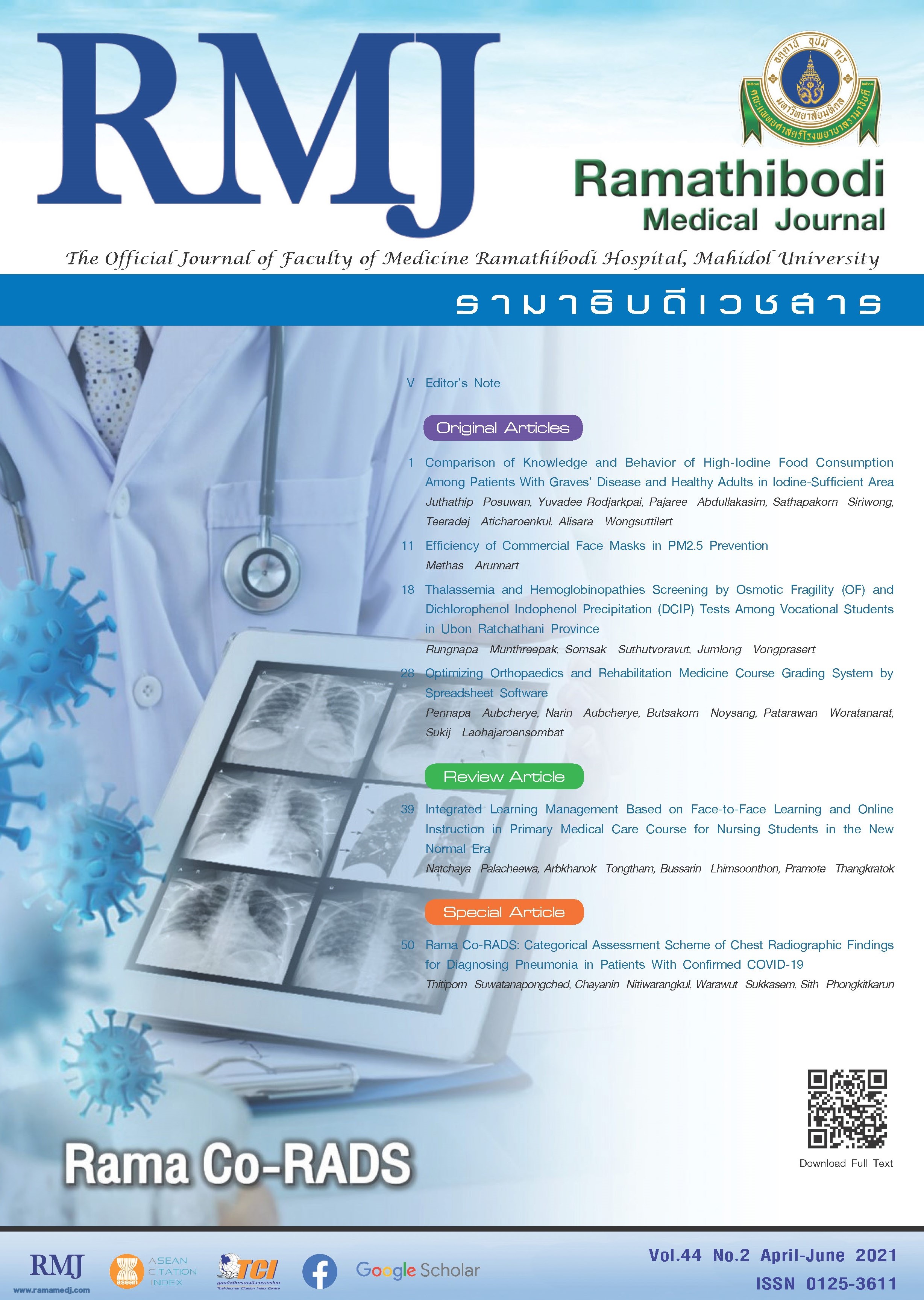Efficiency of Commercial Face Masks in PM2.5 Prevention
DOI:
https://doi.org/10.33165/rmj.2021.44.2.243402Keywords:
Efficiency, Face mask, PM2.5, Particular matterAbstract
Background: Thailand has a high air pollution crisis especially in particle matter smaller than 2.5 microns (PM2.5) which affects health quality. People should prevent themselves by using face masks. However, there are many types of commercial face masks. Each type of face mask does not have the same efficiency.
Objective: To evaluate the efficiency of commercial face masks including supplement filter of face masks in PM2.5 reduction under breathing simulation.
Methods: A tool for evaluating the efficiency of face masks in PM2.5 filtered under breathing simulation was created. Comparisons of the efficiency of each face mask and supplement filter were performed.
Results: N95 mask had the highest efficiency (97.2%) followed by surgical mask (56.3% - 83.2%), cotton cloth mask (40.9% - 42.4%), muslin cloth mask (37.8%), and sponge mask (33.5%), respectively. In the part of the supplement filter, the carbon filter had the highest efficiency (88.3% - 98.8%) followed by face wash tissue (63.3%) and air filter for air conditioner (43.3%), respectively.
Conclusions: N95 mask or surgical mask for PM2.5 prevention should be used in the high air pollution area. If unable to supply, cloth mask with a supplement filter was an alternative solution, and also a carbon filter was recommended.
References
Pinichka C, Makka N, Sukkumnoed D, Chariyalertsak S, Inchai P, Bundhamcharoen K. Burden of disease attributed to ambient air pollution in Thailand: A GIS-based approach. PLoS ONE. 2017;12(12):e0189909. doi:10.1371/journal.pone.0189909.
Greenpeace Thailand. The Pollution particulate matter 2.5 micrometers or less PM2.5 of Thailand January–June 2017. https://www.greenpeace.or.th/s/right-to-clean-air/PM2.5-in-Thailand_Jan-Jun2017.pdf. Accessed November 7, 2020.
Borirak T. The crisis lessons from PM2.5 air pollution. EAU Heritage Journal Science and Technology. 2019;13(3):44-58.
Prachumphan C. PM 2.5 Small Dust in the Air with the Health Crisis that Thai People Have to Exchange. The Standard website. https://thestandard.co/pm-2-5-environmental-nano-pollutants. Published January 26, 2018. Accessed November 7, 2020.
Winitkhetkhamnun U, Phanthirat K. The Development of a Knowledge Book on the Efficiency of Small Dust Masks. Bangkok: The Thailand Research Fund (TRF); 1997.
Shakya KM, Noyes A, Kallin R, Peltier RE. Evaluating the efficacy of cloth facemasks in reducing particulate matter exposure. J Expo Sci Environ Epidemiol. 2017;27(3):352-357. doi:10.1038/jes.2016.42.
Pacitto A, Amato F, Salmatonidis A, et al. Effectiveness of commercial face masks to reduce personal PM exposure. Science of the Total Environment. 2019;650:1582-1590. doi:10.1016/j.scitotenv.2018.09.109.

















